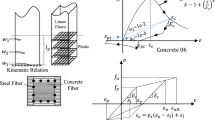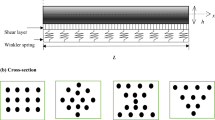Abstract
This study predicts the residual strength of composite structures with impact damage by using the characteristic length of the composite with the hole corresponding to the impact damage area. Since C shaped structure differs from that of the specimen, the shape factor was obtained from the concentration factor of the plate specimen and that of the structure by finite element analysis. The factor was applied to the prediction model for the residual strength of the CFRP composite plate specimen. Comparison between the experimental result and prediction result shows that the prediction method using the characteristic length can be applied to the prediction of the residual strength of CFRP composites after impact.
Similar content being viewed by others
References
Schoeppner, G. and Abrate, S., “Delamination Threshold Loads for Low Velocity Impact on Composite Laminates,” Composites Part A: Applied Science and Manufacturing, Vol. 31, No. 9, pp. 903–915, 2000.
Bahei-El-Din, Y. A., Rajendran, A. M., and Zikry, M. A., “A Micromechanical Model for Damage Progression in Woven Composite Systems,” International Journal of Solids and Structures, Vol. 41, No. 9–10, pp. 2307–2330, 2004.
Ahn, S. S., Hong, S. W., Koo, J. M., and Seok, C. S., “Prediction of Compressive Strength of CFRP Composite Structures using Notch Strength,” Int. J. Precis. Eng. Manuf., Vol. 14, No. 6, pp. 1103–1108, 2013.
Tension-Compression and Tension-Tension Fatigue Life of Woven Fabric Glass/Epoxy Laminate Composites used in Railway Vehicle, Int. J. Precis. Eng. Manuf., Vol. 12, No. 5, pp. 813–820, 2011.
Kim, S. C., Kim, J. S., and Yoon, H. J., “Experimental and Numerical Investigations of Mode I Delamination behaviors of Woven Fabric Composites with Carbon, Kevlar and their Hybrid Fibers,” Int. J. Precis. Eng. Manuf., Vol. 12, No. 2, pp. 321–329, 2011.
Baucom, J. N. and Zikry, M. A., “Evolution of Failure Mechanisms in 2D and 3D Woven Composite Systems under Quasi-Static Perforation,” Journal of Composite Materials, Vol. 37, No. 18, pp. 1651–1674, 2003.
Kwon, Y. W. and Berner, J., “Analysis of Matrix Damage Evolution in Laminated Composite Plates,” Engineering Fracture Mechanics, Vol. 48, No. 6, pp. 811–817, 1994.
Lee, J. D., “Three Dimensional Finite Element analysis of Damage Accumulation in Composite Laminate,” Computers & Structures, Vol. 15, No. 3, pp. 335–350, 1982.
Haberle, J. G. and Matthews, F. L., “The Influence of Test Method on the Compressive Strength of Several Fiber-Reinforced Plastics,” Journal of Advanced Materials, Vol. 25, No. 1, pp. 35–45, 1993.
Chang, F. K. and Kutlu, Z., “Strength and Response of Cylindrical Composite Shells Subjected to Out-of-Plane Loadings,” Journal of Composite Materials, Vol. 23, No. 1, pp. 11–31, 1989.
Hong, S. W., Ahn, S. S., Li, H., Kim, J. K., Ko, S. J., and et al., “Charpy Impact Fracture Characteristics of CFRP Composite Materials according to Variations of Fiber Array Direction and Temperature,” Int. J. Precis. Eng. Manuf., Vol. 14, No. 2, pp. 253–258, 2013.
Kim, S. J. and Chang, S. H., “The Effect of Bias and Shear Angles on Compressive Characteristics of Carbon/Epoxy Plain Weave Fabrics,” Transactions of the KSME. A, Vol. 30, No. 7, pp. 857–864, 2006.
Hamada, H., Maekawa, Z. I., and Haruna, K., “Strength Prediction of Mechanically Fastened Quasi-Isotropic Carbon/Epoxy Joints,” Journal of Composite Materials, Vol. 30, No. 14, pp. 1596–1612, 1996.
Starnes, J. H., Rhodes, M. D., and Williams, J. G., “Effect of Impact Damage and Holes on the Compressive Strength of a Graphite/ Epoxy Laminate,” Nondestructive Evaluation and Flaw Criticality for Composite Materials, ASTM STP, Vol. 696, No. 1979, pp. 145–171, 1979.
Kinsey, A., Saunders, D. E. J., and Soutis, C., “Post-Impact Compressive behaviour of Low Temperature Curing Woven CFRP Laminates,” Composites, Vol. 26, No. 9, pp. 661–667, 1995.
Caprino, G., “On the Prediction of Residual Strength for Notched Laminates,” Journal of Materials Science, Vol. 18, No. 8, pp. 2269–2273, 1983.
Caprino, G., “Residual Strength Prediction of Impacted CFRP Laminates,” Journal of Composite Materials, Vol. 18, No. 6, pp. 508–518, 1984.
Cui, H. P., Wen, W. D., and Cui, H. T., “An Integrated Method for Predicting Damage and Residual Tensile Strength of Composite Laminates under Low Velocity Impact,” Computers & Structures, Vol. 87, No. 7, pp. 456–466, 2009.
Davies, G. A. O., Hitchings, D., and Zhou, G., “Impact Damage and Residual Strengths of Woven Fabric Glass/Polyester Laminates,” Composites Part A: Applied Science and Manufacturing, Vol. 27, No. 12, pp. 1147–1156, 1996.
Chen, V. L., Wu, H. Y. T., and Yeh, H. Y., “A Parametric Study of Residual Strength and Stiffness for Impact Damaged Composites,” Composite Structures, Vol. 25, No. 1, pp. 267–275, 1993.
Koo, J. M., Choi, J. H., and Seok, C. S., “Prediction of Residual Strength of CFRP after Impact,” Composites Part B: Engineering, Vol. 54, pp. 28–33, 2013.
Koo, J. M., Choi, J. H., and Seok, C. S., “Evaluation for Residual Strength and Fatigue Characteristics after Impact in CFRP Composites,” Composite Structures, Vol. 105, pp. 58–65, 2013.
Kim, S. Y., Geum, J. H., Koo, J. M., and Seok, C. S., “Study of Failure Criterion of Hole-Notched Plain-Weave Carbon Fiber Reinforced Plastic (CFRP) Composites,” Transactions of The Korean Society of Mechanical Engineers A, Vol. 34, No. 4, pp. 481–486, 2010.
Whitney, J. M. and Nuismer, R., “Stress Fracture Criteria for Laminated Composites Containing Stress Concentrations,” Journal of Composite Materials, Vol. 8, No. 3, pp. 253–265, 1974.
Nuismer, R. J. and Whitney, J. M., “Uniaxial Failure of Composite Laminates Containing Stress Concentrations,” Fracture Mechanics of Composites, ASTM STP, Vol. 593, pp. 117–142, 1975.
Pipes, R. B., Gillespie, J. W., and Wetherhold, R. C., “Superposition of the Notched Strength of Composite Laminates,” Polymer Engineering & Science, Vol. 19, No. 16, pp. 1151–1155, 1979.
Ahmed, K. S., Vijayarangan, S., and Naidu, A., “Elastic Properties, Notched Strength and Fracture Criterion in Untreated Woven Jute-Glass Fabric Reinforced Polyester Hybrid Composites,” Materials & Design, Vol. 28, No. 8, pp. 2287–2294, 2007.
Kim, J. K., Kim, D. S., and Takeda, N., “Notched Strength and Fracture Criterion in Fabric Composite Plates Containing a Circular Hole,” Journal of Composite Materials, Vol. 29, No. 7, pp. 982–998, 1995.
Tan, S. C., “Finite-Width Correction Factors for Anisotropic Plate Containing a Central Opening,” Journal of Composite Materials, Vol. 22, No. 11, pp. 1080–1097, 1988.
Kim, J. K., Kim, D. S., and Takeda, N., “Notched Strength and Fracture Criterion in Fabric Composite Plates Containing a Circular Hole,” Journal of Composite Materials, Vol. 29, No. 7, pp. 982–998, 1995.
Kim, S. Y., Koo, J. M., Kim, D., and Seok, C. S., “Prediction of the Static Fracture Strength of Hole Notched Plain Weave CFRP Composites,” Composites Science and Technology, Vol. 71, No. 14, pp. 1671–1676, 2011.
Ahn, S. S., Hong, S. W., Koo, J. M., and Seok, C. S., “Prediction of Compressive Strength of CFRP Composite Structures using Notch Strength,” Int. J. Precis. Eng. Manuf., Vol. 14, No. 6, pp. 1103–1108, 2013.
Author information
Authors and Affiliations
Corresponding author
Rights and permissions
About this article
Cite this article
Koo, JM., Choi, JH. & Seok, CS. Prediction of residual strength after impact of CFRP composite structures. Int. J. Precis. Eng. Manuf. 15, 1323–1329 (2014). https://doi.org/10.1007/s12541-014-0472-0
Received:
Accepted:
Published:
Issue Date:
DOI: https://doi.org/10.1007/s12541-014-0472-0




